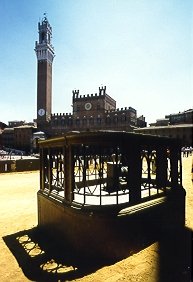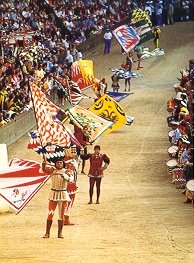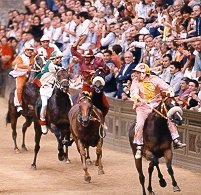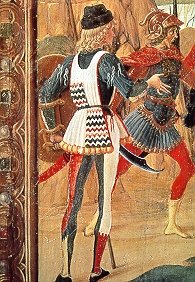 "la tratta", con la quale a ogni contrada viene assegnato mediante sorteggio
un cavallo fra i 10 scelti dopo le batterie. E' un momento importantissimo:
un buon cavallo può essere decisivo: i cavalli che corrono in piazza
sono spesso dei mezzosangue veloci e coraggiosi insieme. Da quel momento,
il cavallo è portato in contrada ed è oggetto di tutte le
possibili attenzioni: deve nutrirsi bene, riposare tranquillo e per questo
è affidato al "barbaresco", un uomo che lo prende in consegna e
vive praticamente con lui i giorni di vigilia cercando di capirne fino
in fondo le possibilità, di farlo rendere poi al massimo
"la tratta", con la quale a ogni contrada viene assegnato mediante sorteggio
un cavallo fra i 10 scelti dopo le batterie. E' un momento importantissimo:
un buon cavallo può essere decisivo: i cavalli che corrono in piazza
sono spesso dei mezzosangue veloci e coraggiosi insieme. Da quel momento,
il cavallo è portato in contrada ed è oggetto di tutte le
possibili attenzioni: deve nutrirsi bene, riposare tranquillo e per questo
è affidato al "barbaresco", un uomo che lo prende in consegna e
vive praticamente con lui i giorni di vigilia cercando di capirne fino
in fondo le possibilità, di farlo rendere poi al massimo  .
Sulla pista infatti, non si scherza: la curva di San Martino che si affronta
in discesa e quella del Casato, in salita, possono diventare trappole micidiali.
Si affrontano quindi le prove cercando di preparare il cavallo e la strategia
della corsa; è il momento del fantino, protagonista anche lui, sebbene
in misura minore del cavallo. Di solito forestiero, di piccola taglia,
ma coraggioso e robusto e, soprattutto, cavaliere eccezionale perchè
il cavallo si monta a pelo, senza sella, e il rischio in caso di caduta
è grave. E' di regola un uomo, anche se qualche donna c'è .
Sulla pista infatti, non si scherza: la curva di San Martino che si affronta
in discesa e quella del Casato, in salita, possono diventare trappole micidiali.
Si affrontano quindi le prove cercando di preparare il cavallo e la strategia
della corsa; è il momento del fantino, protagonista anche lui, sebbene
in misura minore del cavallo. Di solito forestiero, di piccola taglia,
ma coraggioso e robusto e, soprattutto, cavaliere eccezionale perchè
il cavallo si monta a pelo, senza sella, e il rischio in caso di caduta
è grave. E' di regola un uomo, anche se qualche donna c'è  stata;
l'ultima si chiamava Rompicollo (ogni fantino, all'uso toscano, ha un soprannome)
e correva per l'Aquila. Nella notte precedente la corsa, si appronta la
grande cena propiziatoria ove si canta e si brinda, ma anche si stipulano
i patti segreti fra le contrade, opera del capitano e dei "mangini", con
lo scopo di vincere il Palio, ma anche di non farlo vincere alle contrade
rivali. Il giorno del Palio, dopo la "provaccia" finale, il clima si fa
teso e, quando il campanone della torre dà il segnale e i giovani
della "comparsa" indossano i loro splendidi costumi, lo si può percepire
ovunque. In un'atmosfera eccitata, ogni contrada che correrà sul
Campo fa benedire il cavallo; è un momento da non perdere; il "correttore"
dà la sua benedizione al cavallo e al fantino e congeda quest'ultimo
col rituale "và e torna vincitore!". Allora si dà sfogo all'eccitazione
col rullare dei tamburi, lo sventolio delle bandiere, tra una folla sempre
più fitta. L'attesa cresce sempre di più durante la "passeggiata
storica" che precede il Palio; via via tutte le contrade sfilano nei loro
variopinti costumi e, infine, entra il Carroccio, trainato da quattro buoi
di razza chianina, portando il drappellone del palio ("il cencio") salutato
da migliaia di fazzoletti sventolanti. stata;
l'ultima si chiamava Rompicollo (ogni fantino, all'uso toscano, ha un soprannome)
e correva per l'Aquila. Nella notte precedente la corsa, si appronta la
grande cena propiziatoria ove si canta e si brinda, ma anche si stipulano
i patti segreti fra le contrade, opera del capitano e dei "mangini", con
lo scopo di vincere il Palio, ma anche di non farlo vincere alle contrade
rivali. Il giorno del Palio, dopo la "provaccia" finale, il clima si fa
teso e, quando il campanone della torre dà il segnale e i giovani
della "comparsa" indossano i loro splendidi costumi, lo si può percepire
ovunque. In un'atmosfera eccitata, ogni contrada che correrà sul
Campo fa benedire il cavallo; è un momento da non perdere; il "correttore"
dà la sua benedizione al cavallo e al fantino e congeda quest'ultimo
col rituale "và e torna vincitore!". Allora si dà sfogo all'eccitazione
col rullare dei tamburi, lo sventolio delle bandiere, tra una folla sempre
più fitta. L'attesa cresce sempre di più durante la "passeggiata
storica" che precede il Palio; via via tutte le contrade sfilano nei loro
variopinti costumi e, infine, entra il Carroccio, trainato da quattro buoi
di razza chianina, portando il drappellone del palio ("il cencio") salutato
da migliaia di fazzoletti sventolanti.
Dopo un'attesa che pare interminabile, i cavalli escono dall'"entrone" del Palazzo Pubblico e si avviano, fra urla e acclamazioni, ai canapi di partenza. La partenza ("la mossa") è un momento fondamentale; l'ordine di entrata fra i canapi è segreto e viene rivelato dal mossiere al momento del via. I primi nove cavalli entrano uno dopo l'altro mentre l'emozione attanaglia la gola: un buon posto alla "mossa" può voler dire la vittoria ! Non è infrequente il caso che i cavalli un po' per l'eccitazione del fantino, un po' per la tensione che regna tutt'intorno alla mossa, facciano le bizze e costringano a ripetere più volte la partenza.  Il
momento di quest'ultima è scelto dalla decima contrada che parte
"di rincorsa" e solo allora cade la grossa fune che trattiene i cavalli.
Questi scattano a velocità incredibile, con i fantini attaccati
al collo, in un galoppo sfrenato. I tre giri di pista vengono compiuti
circa in un minuto e mezzo. una velocità incredibile tanto che chi
assiste per la prima volta al Palio stenta a raccapezzarsi. Prima ancora
che il colpo di mortaretto decreti la fine della corsa, i contradaioli
vincitori entrano in pista e corrono a prendere in consegna il "cencio"
al grido "daccelo, daccelo !". E' un gran tripudio di bandiere, poichè
ai vincitori si uniscono le contrade amiche, mentre non è raro che
nel frattempo un altro fantino riscuota gli apprezzamenti dei contradaioli
a suon di botte. il Palio portato in contrada trionfalmente, sarà
poi esposto nel museo; cominciano i festeggiamenti che culmineranno con
una grande cena nella quale il cavallo vincitore sarà a capotavola:
si festeggia ma si pensa già al Palio dell'anno prossimo. Il
momento di quest'ultima è scelto dalla decima contrada che parte
"di rincorsa" e solo allora cade la grossa fune che trattiene i cavalli.
Questi scattano a velocità incredibile, con i fantini attaccati
al collo, in un galoppo sfrenato. I tre giri di pista vengono compiuti
circa in un minuto e mezzo. una velocità incredibile tanto che chi
assiste per la prima volta al Palio stenta a raccapezzarsi. Prima ancora
che il colpo di mortaretto decreti la fine della corsa, i contradaioli
vincitori entrano in pista e corrono a prendere in consegna il "cencio"
al grido "daccelo, daccelo !". E' un gran tripudio di bandiere, poichè
ai vincitori si uniscono le contrade amiche, mentre non è raro che
nel frattempo un altro fantino riscuota gli apprezzamenti dei contradaioli
a suon di botte. il Palio portato in contrada trionfalmente, sarà
poi esposto nel museo; cominciano i festeggiamenti che culmineranno con
una grande cena nella quale il cavallo vincitore sarà a capotavola:
si festeggia ma si pensa già al Palio dell'anno prossimo. |
There are 17 contradas, but only 10 race in the Palio; therefore, other than the seven that race because they did not take part in the previous Palio, three are chosen by drawing lots. This process, which takes place the last Sunday in May and the first Sunday after the Palio of July, marks the beginning of the festivities. Three days before the race, an important ceremony is held which is called "la tratta", or "the draw", in which every contrada is assigned by the drawing of lots one of the ten horses selected from the battery. This is a most important moment because a good horse can be decisive; the horses that race in the piazza are often half bloods that are both fast and as well as courageous. From that moment, the horse is taken into the contrada and is given all the attention possible: it has to eat well and rest quietly; for this reason it is entrusted with a "barbaresco", a man that takes it into his care and practically lives with it during the days leading up to the Palio, trying to determine its possibilities and obtain its best performance. On the track, in fact, there is no time for joking. The curve called San Martino that is met going downhill, and another called Casato, which is on an uphill slope, can be deadly traps. The test runs, therefore, are faced with the idea of preparing the horse as well as the strategy for the race; it is also an important moment for the jockey, a protagonist as well even if to a lesser measure than the horse. The jockey is usually a foreigner to Siena, short, but courageous and well built and, most importantly, an exceptional horse rider because he will ride without a saddle and the risk if he falls is grave. As a rule, the jockey is a man, although some women have played the part as well; the last one was called Rompicollo, or "Breakneck" (in keeping with the Tuscan tradition every jockey has a nickname) and she raced for the contrada Aquila (Eagle). The night before the race is the grandiose, propitious dinner where singing and toasting abound, but it is also the time when secret pacts are stipulated between the contradas, work of the captain and the "mangini" (the organizers), with the primary objective of winning the Palio in mind, but also with the goal of not letting the rival contradas win. The day of the Palio, after the "provaccia" (the final trial run), the air gets tense and then when the bell tower sounds the signal and the young people that play a part are all dressed in their splendid, full costumes, the anticipation is felt everywhere. In the middle of a very excited atmosphere, every contrada that will take part in the race in the Campo has its horse blessed. It is a moment that cannot be missed; the "correctore" (priest) performs the benediction of the horse and the jockey and dismisses the latter saying, "Go and come back a winner!". Then the excitement is unleashed with drum rolls and the waving of flags surrounded by an increasingly dense crowd. The anticipation continues to grow during the historic parade that precedes
the Palio; one by one all of the contradas parade around the Campo in their
multi-colored costumes until finally the "Carroccio" (a medieval war cart)
enters, pulled by four oxen and carrying the banner called the Palio (also
called "the cloth"), welcomed by thousands of waving handkerchiefs.
After a seemingly never-ending wait, the horses enter the Piazza del Campo
from the "Entrone" (entrance) of the Palazzo Pubblico and make their way,
surrounded by shouting and applause, to the starting line of the race.
The three laps around the track are completed in about one and a half minutes, at such an incredible speed that those seeing the Palio for the first time can hardly believe it. Even before the explosion of a firecracker declares the end of the race, the members of the winning contrada enter the track and run to claim "the cloth" yelling, "Give it to us! Give it to us!". A great exultation with flags follows, and the contradas that are "friends" of the winners unite with them, while at the same time it is not rare that some other jockeys get treated roughly by their contrada's members as their "thanks" for losing. After the Palio is carried into the contrada, it is displayed in the museum. Then the festivities begin which will culminate in a huge dinner where the winning horse itself is at the head of the table. It is a celebration for all but everyone has already begun to think about the Palio of the following year. |
.
HOME